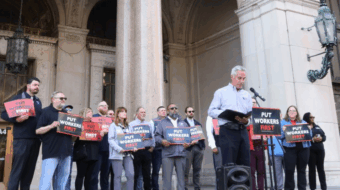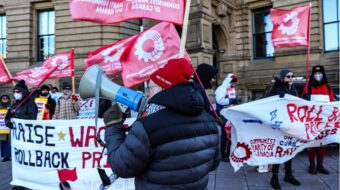The same day that Jocka Jones laid to rest her brother, who was killed trying to rescue six trapped Utah miners, officials of the Crandall Canyon Mine said it would soon be back in business.
Choking back tears during a phone interview Aug. 22, Jones said her brother, Dale Ray Black, 48, “will have died in vain if one more person is killed in that mine.”
With the underground rescue operation halted, the owner of the mine, Robert Murray, suggested that other parts of the mine remained safe for work and that mining should resume. Murray blamed the initial cave-in on an earthquake and denied that the company had been engaged in “retreat” mining, the most dangerous type of mining, often used by companies to retrieve coal out of a largely spent mine.
Lee Siegel, a seismologist at the University of Utah, told the World, “There was no earthquake. The mine cave-in was the earthquake and that’s that.”
Dennis O’Dell, a science writer for the University of Utah and a spokesman for its seismographic stations, said maps showed that “they were doing retreat mining.”
Plus, Crandall Canyon, a nonunion mine, is “extremely dangerous” and “has been repeatedly cited for safety violations,” O’Dell said. “I am sure a lot more will come out in investigations afterwards.”
Jones, along with her grief, has a lot of questions. “We don’t know what to think,” she said. “Someone has dropped the ball here. I don’t know if it is the mine owner or MSHA [the Mine Safety and Health Administration]. If it’s too dangerous to rescue those men, how could it be safe to start up the mine again?”
She said her daughter, away at school, “e-mailed us after the first collapse and told us the mine had been cited by MSHA two years in a row for not having an escape route and for the second violation they were fined only $60 dollars.”
“I buried my brother yesterday,” Jones said. “They have stopped the rescue. How can they send workers down there to resume mining if it’s that dangerous? I don’t want one more worker to die. We’ve got to put a stop to this pillar [retreat] mining. It’s just too dangerous.”
Jones discussed “the hard choices workers here have to face.”
“I don’t want my children to have to go down into a dangerous mine,” she said, “but I have a nephew who is also a miner. He can’t just leave what is a good living for him and his family. What will he do? Where will he go? That coal mine is the way people here have survived.”
Crying, she expressed gratitude to “all the miners and all the people who turned out for my brother’s funeral.” Among the crowds paying respect to her brother, she said, were many relatives of the trapped miners who may forever be entombed under the mountain. “I cried for them,” she said. “At least for me, I know where my brother is. I embraced as many of them as I could, because their suffering is worse than mine.”
Families of the trapped miners, angry over the cessation of rescue efforts, are demanding that a hole be drilled large enough to run a rescue capsule into the collapsed mine. “We need to get that big hole punched to get those big men out,” Cesar Sanchez, whose brother Manuel is trapped, told reporters.
“My brother is trapped underground,” said Steve Allred about his brother Kerry. “They’re basically giving up and that’s
unacceptable. One way or another we’ve got to have closure.”
Jones commented, “The company says such a plan would be too dangerous. But it’s not too dangerous to restart the mine?”
She said she can’t understand why it has taken so long to implement the new safety law Congress passed last year.
After 12 miners were killed at the Sago Mine in West Virginia in January 2006, Congress passed a bill that requires mining companies to track workers deep underground. It was signed into law in June 2006, but allows companies three years to install two-way communication devices and wireless systems that keep aboveground personnel abreast of miners’ whereabouts.
“We can track what goes on underground on Mars,” Jones said. “Can we not do this for my brother and my nephew here in the mine? Their lives count for something, don’t they?”
Union officials have repeatedly criticized MSHA for not pushing mine owners hard enough to rapidly install these systems.
O’Dell said, “The technology is there. The fact is that communication systems like this are in use in European countries, and even if such systems might not have saved these miners, they would at least make it possible to recover their bodies.”
Other union officials had very few, if any, praises for mine owner Robert Murray. Reacting to Murray’s announced plan to re-start the mine, UMWA President Cecil Roberts said, “In an industry long known for having quite a few greedy and uncaring mine operators, this statement is perhaps the most callous I have ever heard.”
jwojcik @pww.org
Related stories on the Utah mine disaster:
Miners’ lives take back seat to profit, by Denise Winebrenner Edwards
Utah mine was unsafe, by John Wojcik









